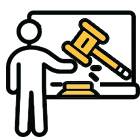Debt Recovery
Debt recovery is an essential component of keeping financial health, no matter if it pertains to individuals or businesses. Disorganized cash flow affects profitability and results in performance delays. This type of cash flow only occurs due to overdue payments or unpaid debts. For individuals or organizations, insights about processes for debt recovery, strategies, and legislative frameworks are essential. This blog will deliver the awareness regarding debt recovery, focusing on legal processes.
What is Debt Recovery?
At its core, debt recovery refers to the process of recovering money that is owed by individuals or businesses to another party. This can include overdue loans, unpaid bills, outstanding invoices, and more. Debt recovery may involve several steps, from gentle reminders to legal actions, depending on the amount and the willingness of the debtor to pay. The primary goal of debt recovery is to secure the owed funds without unnecessarily damaging the relationship between the parties involved.
Debt Recovery Procedures
The debt recovery procedure can be a complex and tedious process. It begins when a payment becomes overdue. The creditor may first attempt to recover the debt through informal means, such as sending reminder notices or calling the debtor. If informal efforts fail, legal actions may be initiated. This can include sending a formal legal notice for debt recovery or filing a suit for recovery of money in court.
Debt recovery procedures are governed by various legal frameworks. In India, the debt recovery tribunal (DRT) plays a pivotal role in facilitating the recovery of debts. The Debt Recovery Tribunal Act provides the legal foundation for setting up DRTs across the country to resolve disputes related to the recovery of debts. The Debt Recovery Tribunal procedure involves filing a claim, attending hearings, and waiting for a verdict.
For businesses, business debt recovery services become crucial when clients fail to pay for goods or services rendered. These services often involve professional agents who follow up with debtors and, if necessary, resort to legal measures.
The Role of Debt Recovery Tribunals
The Debt Recovery Tribunal (DRT) is a special tribunal established to speed up the resolution of debt-related disputes, particularly in cases involving financial institutions, banks, and other creditors. If a bank or financial institution is unable to recover debts through regular means, it can approach the DRT for quicker resolution.
The Debt Recovery Tribunal Act governs the establishment and functioning of these tribunals, and it sets out the jurisdiction and powers granted to the DRTs. The Debt Recovery Tribunal in banking law is significant because it gives banks and financial institutions a dedicated legal forum to pursue their claims against defaulting borrowers.
Many people often search for the debt recovery tribunal case status to track the progress of their cases. These cases can take months or even years to resolve, so staying updated is crucial.
Debt Recovery Agencies
A debt recovery agency plays a key role in the recovery process. These agencies specialize in recovering debts on behalf of individuals, businesses, or financial institutions. They may use various methods, including phone calls, emails, and legal notices, to contact the debtor. Some agencies even specialize in international debt recovery for businesses that deal with clients abroad. These agencies typically charge a fee for their services, either as a flat rate or a percentage of the recovered amount.
For those seeking formal assistance, the Department of Financial Services Debts Recovery Tribunal oversees the regulation of recovery operations in India. These agencies play a crucial role in recovery debt collection, especially for businesses with large volumes of receivables.
The Debt Recovery Appellate Tribunal
If a debtor disagrees with the decision made by the Debt Recovery Tribunal, they have the option to appeal the verdict. This is done through the Debt Recovery Appellate Tribunal, which reviews the decisions made by the DRT and determines whether or not the decision was correct. It ensures that there is a second layer of scrutiny to prevent unjust recovery actions.
Legal Framework for Debt Recovery
In India, the Recovery of Debts Due to Banks and Financial Institutions Act (commonly known as the Debt Recovery Act) was established to facilitate faster recovery of debts due to banks and financial institutions. Under this law, any financial institution, including banks, can approach the Debt Recovery Tribunal to file claims for non-repayment of loans or overdue debts.
Debt recovery in India also follows certain established procedures under the Limitation Act 1980, which prescribes the time period within which a debtor can be legally pursued for outstanding debts.
Bad Debt Recovery and Its Importance
When debts go unpaid for an extended period, they may become bad debts. Recovery of bad debt is a critical function for businesses, especially in terms of managing their cash flow. Bad debt recovery tax treatment varies depending on the country’s tax laws, but businesses often can write off bad debts under specific circumstances. Bad debt recovery cash flow statement plays an important role, as it helps organizations gauge the impact of bad debts on their overall financial health.
One critical aspect of debt recovery is the bad debt recovery process. This involves strategies for tracking overdue accounts and ultimately pursuing legal means to recover the debts. Some businesses may even resort to private debt recovery agencies to handle the collection process on their behalf.
Credit Card Debt Recovery
Credit card debt recovery is another area where specialized legal procedures are applied. Credit card issuers often face challenges in collecting overdue payments, and in some cases, they rely on financial debt recovery collection agencies to recover these debts. Consumers who default on credit card payments may face significant penalties, including an impact on their credit scores.
Key Legal Procedures for Debt Recovery
Regarding legal procedure for debt recovery, the procedure may fluctuate based on specifics of the debt. The conventional approach involves dispatching a debt recovery letter subsequent to a debt recovery legal notice. If these attempts are unproductive, the creditor has the option to file a suit for recovery of money in the designated court.
In situations where the debt is specifically large, creditors are also allowed to file an execution petition for recovery of money. This legal record let the creditor demand a court order for the repossession of assets or wage deductions.
One of the standard legal measures in recovering debt is Order 37 CPC, a requirement as per the Civil Procedure Code (CPC) that regulates the recovery of money through abbreviated procedures. This order is relevant when there is no defense raised by the debtor.
Debt Recovery Costs and Fees
Debt recovery comes with the expense. The debt recovery cost involves the fees for bringing in professionals or agencies, and these costs are based upon the complication of debt and the techniques used for recovery. Debt recovery fees are usually a predetermined amount or a portion of the total debt recovered. These fees can be accumulated, rendering it necessary for creditors to know the expense before heading towards legal recovery.
The debt recovery rate is the essential parameter that shows the percentage of debts recovered by a creditor or agency. Elevated rates demonstrate more effective recovery efforts.
Debt Recovery in India
In a country like India, for debt recovery, various laws and tribunals are made to complete the process. Plenty of private as well as government entities offer debt recovery services in India. These entities are well aware of recovering debts as a representative of creditors. Some of these entities offer online debt recovery alternatives for the ones who opt for digital solutions.
The Debt Recovery Tribunal Act also outlines the guidelines for coping with the recovery of bad debts written off, and creditors usually deal with challenging decisions when addressing such debts. For example, recovery of excess payment demands targeted procedures to ensure proper collection of overpaid amounts.
Enforcing Debt Recovery
After the legal steps are taken and the verdict comes in favor of the creditor, then the next step that comes is enforcement. In the occurrence of forced legal debt recovery, compliance agencies came forward for collecting debt with the help of the selling of assets, seizure of wages, or freezing bank accounts. This is a substantial action and can bring long-term ramifications for the debtors.
The debt recovery letter of demand is the indispensable part of this procedure, clearly revealing the terms as per which the outstanding debt needs to be cleared. In case the debtor is unable to make the payment, legal proceedings and actions could be the next steps with the help of a bad debt recovery agency.
The Role of Debt Recovery Tribunals and Legal Systems
As previously mentioned, what is a debt recovery tribunal, and how are its processes essential to getting in deep in the regulatory landscape of debt recovery? The debt recovery tribunal procedure is regularly used in cases involving extensive business financial obligations, and the process offers a prompt resolution for creditors when compared to traditional judicial processes.
Conclusion
Debt recovery is a comprehensive process that includes legal proceedings, focused agencies, and approaches for recovering overdue payments. From business debt recovery services to international debt agencies, there are multiple resources available to creditors to ensure repayment. Insight into the debt recovery tribunal system, the Debt Recovery Tribunal Act, and the related legal protocols is important for anyone associated with lending or credit operations.
At last, whether it deals with debt recovery for credit cards, bank debt recovery, or debt recovery in banking law, grasping the full scope of the mechanisms in play can make all the difference between recovering successfully and incurring a loss.
FAQ’s
It’s simply chasing the money that’s owed—loans, bills, invoices—whatever hasn’t been paid.
A DRT is a court-like setup that speeds up debt cases, mainly for banks and financial institutions. Less waiting, more action.
In India, the Debt Recovery Tribunal Act gets financial institutions moving to collect what’s owed through a legal route.
Debt recovery agencies are the pros who track down debts—calls, emails, legal notices—they handle the collection while you sit back.
Send reminders, then legal notices, file claims in court or DRT, and follow through until it’s paid. Simple as that.
When money’s overdue for too long, it becomes “bad debt.” Recovery here means pulling out what’s stuck in the system.
If you don’t like the DRT’s decision, the Debt Recovery Appellate Tribunal steps in. It’s the second chance for justice.
You pay fees based on how much you owe or the complexity of the case. The more money recovered, the bigger the cut.






